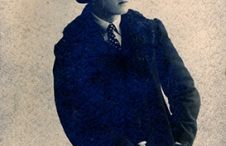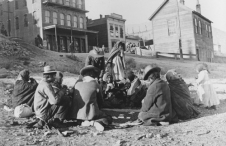A Story of Encounters: Work and Community Life
Many of Nevada’s native and non-native residents developed closer familiarity and genuine friendships by working alongside each other. From the time of the Comstock Lode, indigenous residents of the areas settled by Euro-Americans sought out roles in the new economy that had quickly overtaken their region.
Some of the earliest and most enduring sites of work were ranches and farms, where native residents often found work as seasonal labor. From Paradise Valley in the north to Pahrump Valley in the south, tribal members worked as buckaroos, farmhands, and household workers. Over time, some of these positions became more permanent and of higher status.
Some ranchers took it upon themselves to designate lands where the Indians who worked for and around them could live. Helen J. Stewart, a ranch owner in early Las Vegas, established the Las Vegas Paiute Colony with ten acres of her own land. In the Carson Valley, rancher Bill Dressler donated the land that became the Washoe settlement of Dresslerville.
See below for articles and other materials related to this topic.
VIDEOS
People of the Marsh -- University of Nevada Oral History Program documentary, 2005
People of the Marsh was filmed with the participation and cooperation of members of the Fallon Paiute Shoshone Tribe. The video addresses life in the Stillwater area of northern Nevada. The marshy terrain of the Carson Sink was long inhabited by a band of Northern Paiute people who were joined by a small number of Western Shoshones early in the twentieth century. People of the Marsh features stories and recollections by four tribal members who share their knowledge of a vibrant past and the lifeways that sustained the people. Filmed on location in the Carson Sink, the documentary also uses archival film footage and photographs to provide context for understanding the changes and adaptations caused by the intrusion of thousands of Euro-American emigrants and settlers into their territory.
The Red Mountain Dwellers -- University of Nevada Oral History Program documentary, 2006
This documentary explores the life and experiences of Native Americans in the Fort McDermitt area since the reservation was established in 1936, documenting connections between the people, their natural environment, and traditional culture. Narrator Betty Crutcher introduces the history of her people after Euro-Americans began moving into this lonely region on the Nevada-Oregon border. The film opens with memories of a U.S. military post being built there that was later abandoned, and it comes full circle to how this land is today used as part of the Fort McDermitt Reservation. Sections focus on seasonal subsistence gathering (including the digging and processing of yapa, or wild potatoes), the impact of Euro-American settlement in the region, the emphasis on language education in the schools, and the newer cultural traditions of rodeos and pow wows.
ORAL HISTORY
Albina Redner: A Shoshone Life
A member of the Western Shoshone tribe, Albina Redner was born around 1924 in Austin, Nevada and grew up on a ranch where her stepfather worked as a buckaroo. She attended Stewart Indian School in the mid-1930s. Later enlisting in the Army Medical Corps during World War II, she worked for years as an “Indian doctor” in hospitals and nursing homes.
Arnold R. Trimmer: A Contribution to a Survey of Life in Carson Valley from First Settlement through the 1950s
Arnold Trimmer was born in 1904 and lived in Carson Valley, Nevada beginning in 1909. He describes the Indian community that lived around Genoa through the 1930s and worked on area farms and ranches like the one where Trimmer lived. He describes many of the native practices he witnessed, including trading between the Washoe and Diggger Indians, funeral practices, and traditional gambling games.
Bernice Auchoberry: A Contribution to a Survey of Life in Carson Valley from First Settlement through the 1950s
Bernie Auchoberry, a Washoe, was born in 1914, near the end of a 50-year period when many Washoe families lived and worked on ranches scattered throughout the Carson Valley. Her father was a laborer on one of the largest of these, and Bernice eventually worked in the Minden home of the ranch’s owners. In this 1984 interview, Auchoberry discusses many elements of Washoe life in Carson Valley from the turn of the century through the 1950s.
Carroll Dolve: A Contribution to a Survey of Life and Structures on the Comstock
Born into a mining family in Virginia City, Nevada in 1908, Carroll Gladding Dolve grew up in Virginia City, graduating from the Fourth Ward School in 1925 and returning to the area after several years in San Francisco. She recalls her childhood on the Comstock, including reminiscences of an Indian woman, Annie Davis, who worked for her family and lived in a wickiup at a nearby Indian settlement.
H. Clyde Mathews, Jr.: Autobiography of a Modern-Day Baptist Minister-Life in California, Missionary to the Reno-Sparks Indian Colony, Office of Economic Opportunity, Nevada Politics and Civic Affairs
Interviewed in 1967 and 1968, H. Clyde Matthews discusses his life and work, including ten years spent as a missionary to the Reno-Sparks Indian Colony in the 1950s and 1960s.
Harry Hawkins: Douglas-Alpine History
Harry Hawkins was born in Alpine County, California in 1881. Always interested in and friendly with the local Washoe Indians, Hawkins, interviewed in 1965, is a rich source of information about relations between the Indian and white residents of Alpine County and Nevada’s Douglas County throughout his lifetime and earlier.
Frank Yparraguirre: A Contribution to a Survey of Life in Carson Valley from First Settlement through the 1950s
Frank Yparraguirre was born of Basque parents in San Francisco in 1903. In 1924, he moved to the Minden-Gardnerville area of Carson Valley, where he was in the general store and dry goods business for sixty years. Interviewed in 1984, he shares his memories of life in Minden and Gardnerville from the 1920s through the 1950s, discussing the Basque community and traditions, the changing economy of the area, and the presence of Washoes and other Nevada Indians in the Carson Valley.
Fred Dressler: A Contribution to a Survey of Life in Carson Valley, From First Settlement Through the 1950s
Born in 1898, Fred Dressler was a descendant of some of Carson Valley’s earliest settlers, and operated one of its oldest and most successful ranches. In his 1984 interview, he vividly describes Carson Valley’s agricultural and ranching life. Of particular interest are recollections of Washoe ways and individual Washoe Indians. For over one hundred years, the Dressler family employed Washoe on their ranch, and Washoe families resided on Dressler land well into the twentieth century.
Grace Melissa Dangberg: A Contribution to a Survey of Life in Carson Valley from First Settlement through the 1950s
Grace Dangberg was born in 1896. A granddaughter of H.F. Dangberg, who settled Carson Valley in 1856, Grace grew up on family ranches and in the nascent community of Minden. She studied Anthropology at the University of California and Columbia University, returning to Carson Valley to write a linguistic and cultural study of the Washoe Indians, “Washoe Texts” (University of California Publications in American Archeology and Ethnology, 1927). Interviewed in 1984, she shares many memories of the Washoe community she knew and studied.
John Dressler: Recollections of a Washoe Statesman
John Dressler, a Washoe, was born in 1916, entered Stewart Indian School around 1922, and graduated around 1935. He became a leader of the Washoe in Nevada, working in leadership positions for the Reno-Sparks Indian Colony, Inter Tribal Council of Nevada, and Nevada Indian Affairs Commission. Interviewed in 1970, he discusses the lives of his grandparents and parents and his own experiences working as a ranch hand, welder, and iron worker, and as a leader in the Boy Scouts and Baptist Church.
Marvin Dressler and Ted Sallee: A Contribution to a Survey of Life in Carson Valley from First Settlement through the 1950s
Marvin Dressler and Ted Sallee were born in 1919 and 1920, respectively, to Washoe families living on land owned by non-Indians. By the 1930s both families had relocated to the Dresslerville colony, forty acres set aside for the Indian community in 1917 by Carson Valley rancher William Dressler. In this 1984 interview, Marvin Dressler and Ted Sallee remember their youth in Carson Valley, a time and place rife with segregation, curfews for Washoe Indians, and differential enforcement of local laws.
Phyllis J. Walsh: From Lorgnettes to Lariats – In Loving Recollection of the S Bar S Ranch, Where Work Hardened Our Hands, While Visitors Lightened Our Hearts
Born in 1897 in Philadelphia, Phyllis J. Walsh moved to Nevada in the 1930s to assist in the management of the S Bar S Ranch, located along the Truckee River within the boundaries of the Pyramid Lake Indian Reservation. Interviewed in 1971, she discusses her experiences as a non-Indian living on the reservation, her work as one of the first members of the Nevada Indian Affairs Commission and her interactions with many tribal members throughout the state.
Ruth D. Achard and Margaret D. McDonald: A Contribution to a Survey of Life in Carson Valley from First Settlement through the 1950s
Sisters Margaret McDonald and Ruth Achard, born in 1901 and 1906, respectively, grew up on their family’s ranch, the historic Dangberg Home Ranch, in Carson Valley, Nevada. Interviewed in 1984, the sisters share memories of life on the ranch, including recollections of the many Washoe Indians, both men and women, who worked for their family through the years and lived in a small village nearby.
Winona James: A Contribution to a Survey of Life in Carson Valley from First Settlement through the 1950s
Winona James, a Washoe, was born in 1903 in a galesdangl (winter house) erected on a white man’s property in Genoa. She was raised by her traditionalist grandparents, who alternated their residence between Lake Tahoe fishing camps in the summer and the Van Sickle ranch in Carson Valley in the winter. She attended Stewart Indian School and the Mottsville public school. James shares descriptions of traditional Washoe lifeways from her own experience, as well as stories passed down through her family.
ARTICLES FROM THE NEVADA HISTORICAL SOCIETY QUARTERLY
Articles reprinted with permission from the Nevada Historical Society. Select a link to open a pdf copy of the article.
Article Locations
Related Articles
Further Reading
None at this time.

